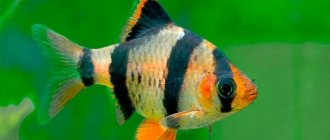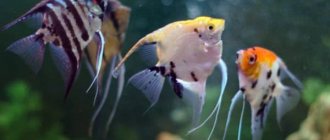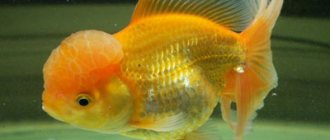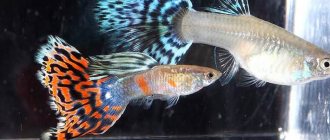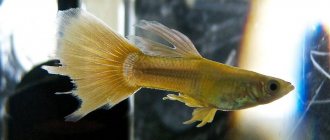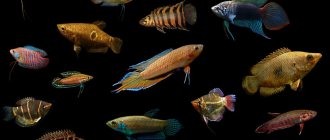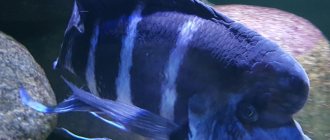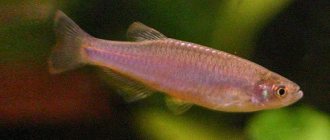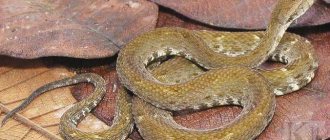Shrimp have “trodden a path” into home aquariums not only for themselves, but also for other members of their family; various crayfish can increasingly be seen in home aquariums. In this article, we will look at the species that are most popular among amateur aquarists and talk about creating optimal conditions for their maintenance.
Currently, there are more than 100 species of aquarium crayfish. We will get acquainted with the eight most popular of them: Mexican Dwarf Crayfish, Red American Swamp Crayfish, Blue Crayfish, Australian Red Claw Crayfish, Zebra Crayfish and Blue Florida Crayfish, Marbled and Cuban Crayfish in this article, but first we will focus on the general aspects.
Water temperature in an aquarium with crayfish
Most crayfish prefer cooler water than fish; on average, a temperature of 19-25 degrees is suitable.
Filtration and aeration for aquarium crayfish
There is no such thing as too much filtration - folk aquarium wisdom. For crayfish it is even more true than for fish. The fact is that crayfish like to hide food for themselves in reserve; the stash of uneaten food spoils and releases harmful substances (nitrogen compounds) into the water, therefore, the more powerful the filtration in the aquarium, the better. We recommend a filter with a capacity of 10-15 volumes of your aquarium per hour. If the filter creates too strong a flow, you can use various devices to cut the flow, such as a flute.
No matter how powerful the filtration is, you cannot do without changing the water in the aquarium. In large aquariums, you can do 50% water changes once a week; if the volume of the aquarium is small, it is better to do 20-30% changes a couple of times a week.
The aeration in an aquarium with crayfish must be strong enough, since if there is a lack of oxygen, the crayfish may try to leave the aquarium through the wires and filter tubes.
Aquarium crayfish and plants
Home keeping of river crustaceans
It is advisable to place river representatives in separate tanks. They require an environment that is as close to natural as possible. Therefore, the owner needs to take care of the following:
- Suitable housing . You should immediately start with a spacious container with a volume of more than 80 liters, with vegetation and a sandy bottom.
- Filter apparatus and aeration . These must be powerful systems capable of filtering large volumes of water. Before purchasing a suitable device, it is necessary to calculate the filtration activity of the aquatic environment. This is an important point, since outbreaks of bacterial infections often occur in the home of crayfish. Such phenomena are associated with the habit of these inhabitants of hiding food in burrows, which rots and decomposes over time. As a rule, biological filters are unable to cope with this task; the water becomes cloudy and acquires a musty smell. An installed filter apparatus can save the situation, without which the crayfish will often get sick and die.
- Grunte . The layer should be at least 6 cm. The material is used in such a way that it is easy for the inhabitant to burrow into it - medium-sized river pebbles, particles of red bricks are suitable, or you can purchase a special filler of artificial origin at a pet store. As a last resort, soaked expanded clay may be used. Using decorative ceramic shelters instead of soil will not prevent crayfish from tearing holes, but it is a good protection, especially when it comes to small swamp crustaceans.
- Vegetation and driftwood . They are needed because crayfish build shelters next to them, placing a hole near the rhizomes, which gives stability to the structure. Landscaping provides the necessary balance to the ecological system and is also used by the inhabitants as shelters. When selecting algae, it is better to give preference to species that have a powerful root system and large leaves. Aponogetons and cryptocorynes meet these requirements. Plants require appropriate care, since crayfish often touch the rhizomes while digging holes.
- Replacement and replacement of water . When germ levels rise, the water in the tank is replaced. The most suitable liquid for this is borrowed from another tank with fish - it will not disturb the microenvironment and will contribute to the rapid restoration of biobalance. The entire water should be replaced monthly to reduce the level of toxic substances, nitrates and enrich with oxygen. This is beneficial to both the inhabitants and the vegetation.
- Maintaining water parameters . Crayfish are unpretentious, but it will still be good if the artificial habitat is as close as possible to the natural one. And, first of all, it is necessary to maintain certain water parameters: temperature - from 20° to 26°C; acidity – 5-8 pH; hardness is not important, but when living in too soft water, crustaceans develop health problems, and they have a hard time molting and take longer to recover.
Lighting does not play a special role, since crayfish are most often awake at night. However, it is required for good plant growth and development.
Compatibility of crayfish with aquarium fish
The issue of compatibility between crayfish and aquarium fish gives rise to many disputes on aquarium forums. It is better to keep crayfish separately from fish and here's why.
The proximity of dwarf crayfish and small aquarium fish is possible, however, it is associated with some problems. During the molting period, crayfish are extremely defenseless during the first day, until the shell hardens. Even small fish, like microrasbor, can seriously injure or even kill crayfish. The rest of the time, on the contrary, cancer, which is a predator by nature, can attack small fish and injure them.
The proximity of crayfish to large fish is excluded. Cancer will starve, afraid to get out of the shelter in search of food, and everything will end in tears.
How to distinguish a male from a female
Is it possible to do this? Quite a difficult task, because dwarf crayfish are too small, and their genitals are quite well hidden.
In males, judging by reviews from aquarists, the genitals are presented in the form of two tubes. These tubes are located next to the last pair of legs. In the female, the primary sexual characteristics are hidden under the third pair of legs and have a rounded shape.
To distinguish a male from a female, it is not necessary to look at the genitals. Experienced aquarists claim that “men” have longer and pointed claws, and their bodies are more massive than those of the female crayfish.
Molting of aquarium crayfish
Molting of aquarium crayfish
It's no secret that all crustaceans molt periodically. Replacing the old chitinous shell with a new one is the only way to grow. Juveniles molt frequently, about once a week. Adult dwarf crayfish molt less frequently. During the molting period, it is especially important for crayfish to have a shelter where the animal remains until its new shell hardens. Also, molting is a way to restore lost limbs. Crayfish lose them under a variety of circumstances (the claws are most often affected). The cancer can also lose its legs during the molting itself - if the cancer cannot remove any limb from the old shell, it tears it off or chews it off. In both the first and second cases, this phenomenon is called autotomy. In general, if you suddenly see a crayfish with one claw, don’t worry, it will soon grow back during the next molt.
Tetra vital for aquarium crayfish
The success of molting depends on many factors. One of them is the presence of calcium in water. Calcium is the basis of chitin for the shell. An element such as iodine is also very important. It is a coenzyme for the synthesis of chitin. With iodine deficiency, there is a high probability that the cancer will not be able to molt and will die. Therefore, if crustaceans live in your aquarium, iodinol is your best friend. Of the branded drugs, we can recommend Tetra Vital , which also contains iodine.
The most common types
Aquarium crayfish are used quite often as pets. There are about a hundred species of arthropods. Each of them requires special care and feeding. Some types of aquarium crayfish have unimpressive sizes and can be kept with other tank inhabitants. Let's look at the most famous representatives of arthropods:
Florida Californian crayfish have a peculiarity - a bright red body color. Adapts well to various living conditions and is unpretentious in care and nutrition. The length of the body varies between 13–15 centimeters. The aquarium must be covered, as representatives of this species can escape from the tank.
The Louisiana dwarf crayfish lives in the rivers and lakes of Texas, USA. The body length is 3 centimeters. These individuals are similar in size to dwarf swamp crayfish. A characteristic feature for it is the presence of a dark spot on the shell. The back is strewn with small black dots. Due to its small body length, it gets along well with fish and does not pose any danger to them. It uses dead parts of algae and pieces of dead fish as food. The average lifespan of this species is two years. For a comfortable life you need shelter.
Feeding aquarium crayfish
Feeding aquarium crayfish
Feeding crayfish does not present any difficulties. Omnivorous. Food tablets for catfish-like fish and sinking granules crack especially well. They enjoy eating live food: bloodworms, brine shrimp, daphnia, etc. Scalded pieces of cucumber, zucchini, and carrots are great to eat. It is worth noting that crayfish are considered “aquarium orderlies” - they will always eat carrion.
There are also specialized foods for aquarium crayfish. For example, Tetra Crusta Menu for a varied and nutritious diet of shrimp and crayfish.
As a treat, you can offer pieces of squid and fish. But still, the emphasis in feeding should be on plant foods. Adult crayfish are fed not every day, but three times a week. Only actively growing and frequently molting fry are fed daily. It is useful to add red-brown oak leaves to the diet of crayfish; they are a light natural antiseptic and have a positive effect on the cancer’s immunity.
Interesting Facts
- Many species of dwarf crayfish have this peculiarity: when they want to eat, they raise their claws and hurry to the glass wall of the aquarium.
- Crayfish like to climb up the stems of long plants and hang upside down at the top. When this happens for the first time, owners panic: is everything okay with their pets?
- Cancers are active both day and night, so it’s convenient to spy on their lives.
- Dwarf crayfish often behave like real bullies, and they can threaten with their claws not only their own kind, but also larger specimens, according to the principle “ah, Moska!”
Breeding aquarium crayfish
Breeding aquarium crayfish
If the aquarist has managed to create good conditions for the life of crayfish: the water in the aquarium is clean, the pets are well-fed and feel safe, then no special stimulation is required to awaken the reproductive instinct. Mating usually begins after the female molts; she releases pheromones into the water, to which the male immediately reacts. The mating process is less like love games and more like a ruthless battle that lasts for several hours. If the female is much smaller and weaker than the male, he may even accidentally kill her. It is advisable to keep several females and one male in the aquarium; the male is able to fertilize several females in a short period of time. It is better to place a pregnant female carrying eggs under her tail in a separate aquarium so that she is not subject to aggression from the male. The gestation period depends on the size of the crayfish; in the dwarf Mexican crayfish, the crayfish are born after 14 days, while large blue crayfish bear offspring for up to 40 days. The appearance of small crustaceans requires special attention from the aquarist. It is necessary to monitor the quality of water, the most important thing is to control the content of nitrogenous compounds and make timely water changes. It is also necessary to sort the crustaceans; the juveniles grow unevenly and larger individuals will gladly eat smaller relatives. The starting food is the same as for fish: ciliates, brine shrimp, you can grind fish food into dust.
Reproduction
Aquarium crayfish make interesting pets. Reproduction of individuals will not cause problems if the proper conditions are created. Sometimes it is not possible to carry out this process, since all the inhabitants are of the same sex.
The size of individuals, as well as living conditions, vary significantly between species. Most crustaceans reach sexual maturity after reaching three months of age. Male individuals ready to reproduce can also be recognized by bright red stripes on their claws. There must be at least 2 females per male, since after fertilization he can eat her.
Diseases of aquarium crayfish
Aquarium crayfish also get sick, and, unfortunately, unlike fish, treatment for most crustacean diseases has not been developed; the sick individual dies in almost 100% of cases.
Various parasitic diseases:
Various parasites, such as microscopic worms and leeches, can settle on the shell of crayfish; you can get rid of them by giving your pet salt baths.
Epistilis is the colonization of the crayfish shell by various protozoa. Visual signs - the cancer is covered with a brown or grayish coating. The cause of the disease is most often poor living conditions, dirty water, inappropriate temperature, which causes a decrease in the cancer’s immunity, and its body ceases to cope with the surrounding pathogenic microflora.
Shell disease. The manifestations of shell disease are as follows: after molting, the shell of the cancer remains soft not for a day, as expected, but much longer. The cause of the disease is insufficient water hardness and unbalanced nutrition. Add small snails to the crayfish’s diet and increase the water hardness using special sets of salts, and everything will go away.
Plague of crayfish . An extremely dangerous disease caused by fungi - Aphanomices astaci. White, brown or red spots appear on the tail of the diseased crayfish, and black spots appear on the body. The behavior of the cancer changes, uncertainty appears in the gait, the cancer becomes active during the day, over time the gait becomes more and more unsteady, all ends with convulsions and the death of the cancer, the cancer patient must be isolated as soon as you notice the symptoms, since the disease is contagious.
Rust spot disease . Another fungal disease caused by members of the genus Mucedinaceae. The manifestations of the disease are clear from the name - spots similar to rust appear on the body of the crayfish, over time the shell in these places softens, deep ulcers form, tissue necrosis begins, and ultimately the animal dies. There is no effective treatment. A cancer patient must be isolated from others.
Porcelain disease. With this disease, the entire musculoskeletal system of the cancer is paralyzed, and the cancer inevitably dies from exhaustion. No treatment has been developed.
Handsome Patzcuaro
We will talk about tangerine cancer. It has several names: orange, tangerine or patzcuaro. The baby received its last name in honor of the Mexican lake, which is its main habitat.
The bright shell of the crayfish is the result of selection work; its natural color is dark brown. You can see spots or stripes on the body that clearly appear. This species is slightly larger than its swamp companion: males grow up to 4.5 centimeters. Females are larger, but are not able to grow more than 6 centimeters.
When buying orange crayfish, you should know that they are very cocky and will not be able to get along with other species.

